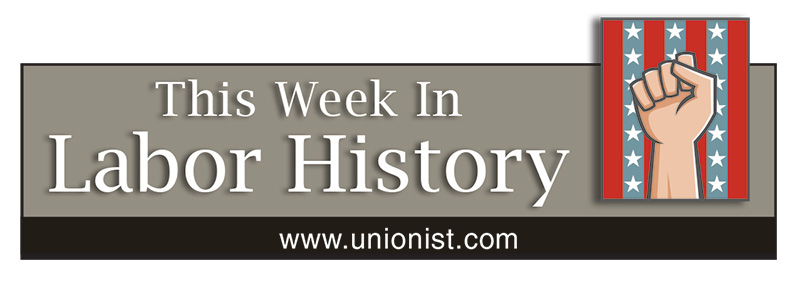This week in labor history: January 9-15

JANUARY 9
1918 – A mediation commission appointed by President Woodrow Wilson finds that “industry’s failure to deal with unions” is the prime reason for labor strife in war industries.
1922 – Eighty thousand Chicago construction workers strike.
1939 – Southern Tenant Farmers’ Union leads Missouri Highway sit-down of 1,700 families. They had been evicted from their homes so landowners wouldn’t have to share government crop subsidy payments with them.
JANUARY 10
1860 – In what is described as the worst industrial disaster in state history, the Pemberton Mill in Lawrence, Mass., collapses, trapping 900 workers, mostly Irish women. More than 100 die, scores more are injured in the collapse and ensuing fire. Too much machinery had been crammed into the building.
1914 – Wobbly organizer and singer Joe Hill allegedly kills two men during a grocery store hold-up in Utah. He ultimately is executed by firing squad (His last word was “Fire!”) for the crime despite much speculation that he was framed.
2004 – The Supreme Court lets stand implementation of North American Free Trade Agreement (NAFTA) despite the lack of an Environmental Impact Statement.
JANUARY 11
1912 – The IWW-organized “Bread & Roses” textile strike of 32,000 women and children begins in Lawrence, Mass. It lasted 10 weeks and ended in victory. The first millworkers to walk out were Polish women, who, upon collecting their pay, exclaimed that they had been cheated and promptly abandoned their looms.
1936 – Nearly two weeks into a sit-down strike at GM’s Fisher Body Plant No. 2 in Flint, Mich., workers battle police when they try to prevent the strikers from receiving food deliveries from thousands of supporters on the outside. Sixteen strikers and spectators and 11 police were injured. Most of the strikers were hit by buckshot fired by police riot guns; the police were injured principally by thrown nuts, bolts, door hinges and other auto parts. The incident became known as the “Battle of the Running Bulls.”
1995 – National Hockey League owners end a player lockout that had gone for three months and 10 days. A key issue was owner insistence on a salary cap, which they won.
JANUARY 12
1919 – Seattle Mayor Ole Hanson orders police to raid an open-air mass meeting of shipyard workers in an attempt to prevent a general strike. Workers were brutally beaten. The strike began the following month, with 60,000 workers walking out in solidarity with some 25,000 metal tradesmen.
1942 – President Roosevelt creates the National War Labor Board to mediate Labor disputes during World War II. Despite the fact that 12 million of the nation’s workers were women — to rise to 18 million by war’s end — the panel consisted entirely of men.
JANUARY 13
1874 – The original Tompkins Square Riot. As unemployed workers demonstrated in New York’s Tompkins Square Park, a detachment of mounted police charged into the crowd, beating men, women and children with billy clubs. Declared Abram Duryee, the Commissioner of Police: “It was the most glorious sight I ever saw…”
1924 – As the nation debates a constitutional amendment to rein in the widespread practice of brutally overworking children in factories and fields, U.S. District Judge G.W. McClintic expresses concern, instead, about child idleness.
JANUARY 14
1995 – Pennsylvania Superior Court rules bosses can fire workers for being gay.
2003 – Some 14,000 General Electric employees strike for two days to protest the company’s mid-contract decision to shift an average of $400 in additional health-care co-payments onto each worker.
2014 – A 15-month lockout by the Minnesota Orchestra against members of the Twin Cities Musicians’ Union Local 30-73 ends when the musicians agree to a 15 percent pay cut (management wanted up to 40 percent) and increased health care cost sharing. They did win a revenue-sharing deal based on performance of the orchestra’s endowments. It was the nation’s longest-running contract dispute for a concert orchestra.
JANUARY 15
1919 – Seventeen workers in the area die when a large molasses storage tank in Boston’s North End neighborhood bursts, sending a 40-foot wave of molasses surging through the streets at an estimated 35 miles per hour. In all, 21 people died and 150 were injured. The incident is variously known as the Boston Molasses Disaster, the Great Molasses Flood and the Great Boston Molasses Tragedy. Some claim that on hot days, the area still smells of molasses.
(Compiled by David Prosten, founder of Union Communication Services)
